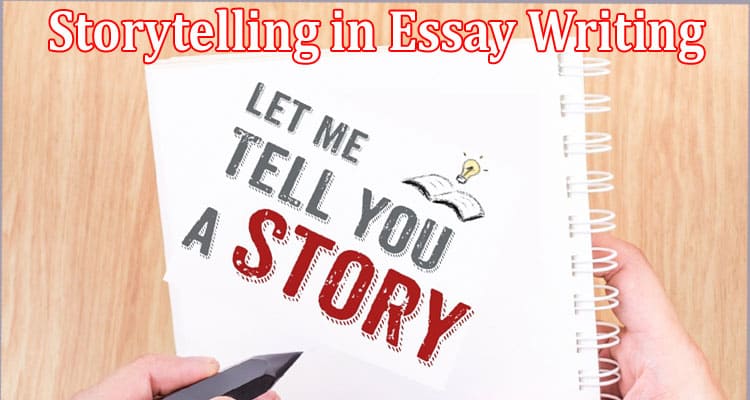The Power of Storytelling in Essay Writing
Whether you believe it or not, storytelling is an excellent way to build a connection with your reader and the ideal audience. So, if you can somehow master this skill, I’m sure you can use it on your way to essay writing. And it’d sell pretty well too, considering how professors tend to like to become a reader while checking someone’s essay.
But, the question is – how can you develop this amazing skill?
Truth be told, it does take a lot of time to master the art of storytelling. But if you’re persistent enough and follow the right path, I’m sure you can do wonders in this regard.
What is Storytelling?
Storytelling, in essence, is a writing technique that you can use to offer some information on a topic through a simple yet subtle story. It is basically used to hook the writer’s audience to the message they are trying to portray and prompt them to keep reading.
But, how do you really use it while writing an essay?
Before we answer that, let’s first learn more about what an essay actually is.
Well, most people think an essay is just a collection of words where you convey a message in accordance with the given topic. Nonetheless, that’s not true. An essay is a structured piece of writing that conveys ideas, arguments, and insights in a coherent and engaging manner.
A well-crafted article showcases the writer’s understanding of the subject matter while also capturing the reader’s attention and guiding them through a logical thought process.
Connecting Storytelling with Essay Writing
At its core, storytelling is a fundamental aspect of human communication. Since ancient times, humans have used stories to convey information, share experiences, and pass down wisdom from one generation to another.
Storytelling taps into our innate curiosity and emotional resonance, making it an effective way to convey complex ideas in a relatable and engaging manner.
When you infuse storytelling into your essay writing technique, you’re essentially breathing life into your words. You’re not just presenting facts and arguments; instead, you’re creating a narrative that unfolds in the mind of your reader. This narrative structure helps in holding your reader’s attention and guiding them through your essay with a sense of anticipation.
The Elements of Storytelling
Although it might seem a little abrupt, you simply cannot start writing a story out of nowhere. There are some elements that you need to follow while you are at it.
The following are a few of them.
1. Characters
Just like in a captivating novel, your essay should have characters. These characters might not be people, but they can be concepts, historical figures, or even conflicting viewpoints. Give these “characters” distinct personalities or attributes that resonate with your essay’s theme.
2. Setting
Set the stage for your essay’s narrative. Provide context and background information to immerse your reader in the world you’re presenting. Whether you’re writing about a historical era or a conceptual landscape, the setting adds depth to your storytelling and makes it better.
3. Conflict and Resolution
Every good story has an internal conflict that drives the narrative forward. In the context of an essay, this conflict might be a central question, a debate, or a problem that needs solving. Your essay’s progression then becomes a journey toward resolving this conflict.
4. Emotion
Emotion is the lifeblood of storytelling. Hence, make sure to infuse your essay with emotional resonance by connecting your ideas to human experiences. Whether it’s empathy, curiosity, surprise, or inspiration, evoking emotions helps your readers connect on a personal level.
5. Plot Arc
Craft a clear structure that guides your reader through your essay. Just as most stories have a beginning, middle, and end, your article must flow logically, build tension, present arguments, and ultimately lead to a satisfying conclusion.
6. Imagery and Descriptive Language
Paint a vivid picture with your words. If possible, you should also use descriptive language and imagery to transport your reader into the world you’re presenting. Engage their senses and help them visualize the concepts you’re discussing. It’ll make them feel what you’re saying.
7. Narrative Voice
Your narrative voice sets the tone for your essay. Whether it’s conversational, informative, or persuasive, be sure to go for a voice that aligns with your essay’s purpose and resonates with your target audience. The more efficient and accurate you are with it, the better.
Note: Although these are some of the important aspects of storytelling, they are not limited to what we’ve talked about here. So, be sure to research more and create your essay accordingly.
Why Does Storytelling Work in Essays?
Storytelling is an excellent way to convey your message across the audience without making a single of them bored. But, how do they really work in essays? Is there something that you will need to focus on? Or, do you just start writing however you want?
Let’s keep reading to know more about it.
1. Engagement
Human brains are wired to respond to stories. When you integrate storytelling into your essays, you capture your reader’s attention right from the start. The promise of a narrative journey encourages them to stay invested in your piece.
2. Retention
We remember stories far better than dry facts or abstract concepts. By weaving a story within your essay, you’re increasing the chances that your reader will remember and understand the information you’re presenting.
3. Complex Ideas Made Accessible
Storytelling has a unique ability to simplify complex ideas. By illustrating abstract concepts through relatable stories, you make your content more accessible and easier to grasp.
However, according to one of the best essay writing services, you also cannot make the idea a little too difficult. It might not resonate with your audience then.
4. Emotional Connection
Emotion is a powerful tool for conveying meaning and impact. Stories evoke emotions, and these emotions, in turn, create a quite deeper connection between your reader and your essay’s content. So, make sure to work on this as actively as you can from the beginning.
5. Enhanced Persuasion
If your essay has a persuasive angle, storytelling can be your secret weapon. Instead of bombarding your reader with data and arguments, you can present a compelling narrative that subtly leads them to your desired conclusion.
6. Flow and Coherence
A well-structured story naturally guides your reader through the essay. It helps maintain a seamless flow, preventing your essay from feeling disjointed or fragmented.
7. Uniqueness and Originality
Storytelling sets your essay apart. Your personal narrative voice and the stories you choose to tell are inherently unique to you, making your essay stand out from the sea of generic content.
How to Incorporate Storytelling into Your Essays?
Now that you’re convinced of the power of storytelling, let’s discuss practical strategies to infuse storytelling into your essay writing process:
1. Choose the Right Anecdotes
Anecdotes are short, illustrative stories that support your main points. They can be personal experiences, historical events, or even hypothetical scenarios. The key is to select anecdotes that enhance your essay’s themes and resonate with your audience.
2. Create Vivid Introductions
Start your essay with a compelling hook that draws your reader into the narrative. This could be a captivating anecdote, a thought-provoking question, or a bold statement that sets the tone for the story you’re about to tell.
3. Transition with Narratives
Incorporate storytelling as a bridge between different sections of your essay. Instead of abrupt transitions, try to craft narratives that smoothly guide your reader from one point to the next. I would also ask you to use proper words so that the essay feels easier to read.
4. Incorporate Dialogue
If appropriate, include snippets of dialogue to bring your characters or concepts to life. Dialogue adds authenticity and immediacy to your storytelling. However, as it’s a school and/ or college essay, be sure not to write something explicit. It’ll get you into trouble.
5. Build Tension and Resolution
Just like a classic story, build tension as you progress through your essay. Present conflicts or challenges and, then, lead your reader toward resolutions or insights that offer a sense of closure. The better you do it, the more enthralling your article will seem while reading.
6. Appeal to the Senses
Engage your reader’s senses by incorporating sensory details. Describe sights, sounds, smells, tastes, and textures to create a more immersive experience.
7. Balance with Analysis
Remember, while storytelling is powerful, analysis and critical thinking are still crucial in essay writing. After sharing a story, connect it back to your essay’s main argument, demonstrating how it supports your point.
The Bottom Line
The journey of our sapling mirrors the trajectory of environmental conservation—a journey that requires storytelling as much as it does science. Through narratives like this, we tap into the innate human desire for connection and understanding. We realize that the power to rewrite the ending of our environmental story lies within our hands. The narrative of our planet’s survival depends on the stories we tell and the actions we take.
In any case, that will be all for this article. If there’s anything else you want to know about, be sure to comment below. We’ll try to help you out as much as we can.




